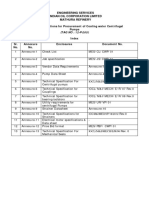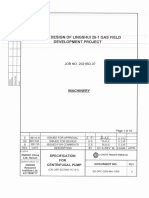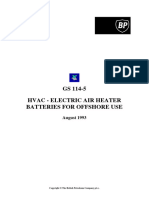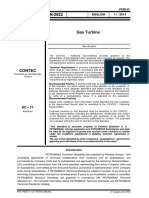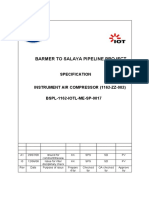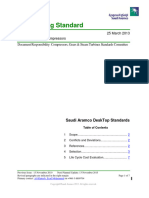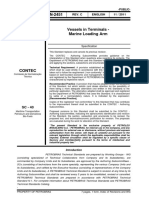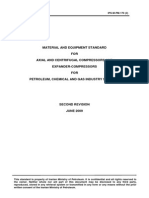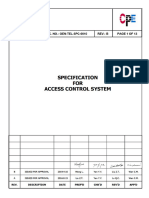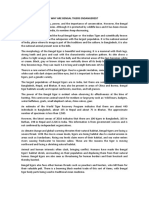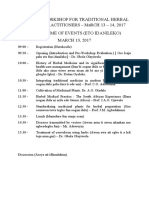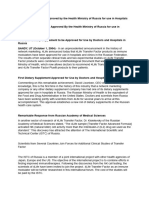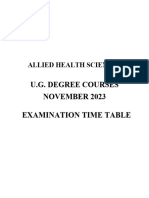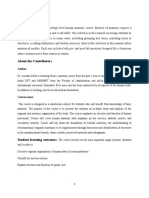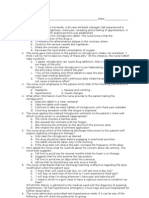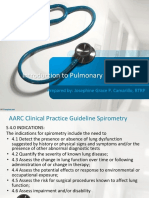Sched w4
Sched w4
Uploaded by
yvCopyright:
Available Formats
Sched w4
Sched w4
Uploaded by
yvOriginal Title
Copyright
Available Formats
Share this document
Did you find this document useful?
Is this content inappropriate?
Copyright:
Available Formats
Sched w4
Sched w4
Uploaded by
yvCopyright:
Available Formats
AL FURAT PETROLEUM COMPANY SCHEDULE “W-4”
ENGINEERING CONTROLLED DOCUMENT
STANDARD SPECIFICATION FOR
CENTRIFUGAL PUMPS
Custodian: SEE/1
Revision no: 1 Date: 20/03/01 File name: W-4
Administered by: Verified: Date: Verified: Date: Approved: Date:
SEE/13 SEE SES
SEE/1
Date: 20/03/01
Reason for revision: General revision incorporating experience to date.
This document contains proprietary information and is intended for use by AFPC staff
only. The contents of this controlled document shall not be altered without formal
approval of the document Custodian.
PAGE 1 of 13 MARCH 2001
AL FURAT PETROLEUM COMPANY SCHEDULE “W-4”
SCHEDULE W-4
STANDARD SPECIFICATION FOR CENTRIFUGAL PUMPS
AL FURAT PETROLEUM COMPANY
March 2001
Rev. 2
TABLE OF CONTENTS
1.0 SCOPE AND DEFINITIONS
2.0 GENERAL REQUIREMENTS
3.0 REFERENCE STANDARD SPECIFICATIONS
4.0 SPECIFIC DESIGN REQUIREMENTS
5.0 CONTRACTOR DATA REQUIREMENTS
l.0 SCOPE AND DEFINITIONS
PAGE 2 of 13 MARCH 2001
AL FURAT PETROLEUM COMPANY SCHEDULE “W-4”
1.1 This standard specification covers the minimum requirements of Al Furat Petroleum Company for
the design and construction of centrifugal pumps and related auxiliaries for use in onshore oil and gas (related)
operations.
1.2 Within this specification the following definitions shall apply:
COMPANY : Al Furat Petroleum Company or a designated Contractor
(Engineer/Constructor) performing work on behalf of Al Furat Petroleum Company.
CONTRACTOR : The Contractor, Vendor or Manufacturer selected by COMPANY to perform the
work or provide equipment and services as described in this specification.
INSPECTOR : The individual(s) designated by COMPANY to act on COMPANY's behalf for all
matters relating to Quality Control, Testing, and Acceptance of the work.
RFQ : COMPANY's Request For Quotation.
2.0 GENERAL REQUIREMENTS
2.1 The pump package to be designed and constructed according to this Schedule will be
operated semi- attended in a remote desert area. It will be operated and maintained by production
personnel with only periodic maintenance by trained mechanics.
2.2 Of primary concern to COMPANY are safety, operability, reliability and maintainability of its
facilities. As CONTRACTOR shall be ultimately responsible for the safe operation of the equipment
supplied by him, he shall include the following activities in his Scope of Supply:
- Review all safety features and systems which COMPANY has specified and suggest, in writing, all
revisions and additions which he feels necessary.
- Review operation and integrity of entire control and shutdown system.
- Review equipment location and layout to permit easy access for maintenance and operation.
- Propose any alternatives which will, in his opinion, result in improved safety, operability, reliability
or maintainability
2.3 Pump ratings shall not exceed the limits of the manufacturer’s proven design and shall be well within
his actual experience. Only equipment which has proven its reliability in similar service will be
acceptable. Similar service and actual experience are defined as follows:
The manufacturer shall have at least three pumps of the same model in proven operation under
comparable service conditions including liquid type, suction/discharge pressures and temperatures, and
capacity, at the time of bid. These units shall have similar design features to the units proposed,
including: operating speed/speed range, staging arrangement, shaft sealing, bearing design, casing/casing
joint design, material selections and load coupling design.
CONTRACTOR shall include appropriate reference data with his bid to demonstrate that the
above requirements are met by his proposed design.
2.4 All items of equipment and materials shall comply with the latest edition of the listed Schedules, Codes
and Standards and with those referenced therein, and with the requirements of this Schedule, the data
sheets and the RFQ Document. CONTRACTOR shall advise COMPANY, with his bid, of any
exceptions to or deviations from the Schedules, Codes and Standards and submit specific details, and
obtain COMPANY's approval prior to award.
2.5 In the absence of a COMPANY specification or a relevant international code the design shall be
in accordance with CONTRACTOR's specification or standard, which shall adhere to accepted design
PAGE 3 of 13 MARCH 2001
AL FURAT PETROLEUM COMPANY SCHEDULE “W-4”
methods and good engineering practice, and shall be supplied to COMPANY for review prior to
its adoption.
2.6 In the event of a conflict arising between the requirements of the RFQ, this Schedule, the Data Sheets
or any of the applicable Schedules, Codes and Specifications, such discrepancy shall be brought to the
attention of COMPANY in writing.
3.0 REFERENCE STANDARD SPECIFICATIONS
In addition to the requirements contained herein, the requirements of the following Standard
Specifications for COMPANY shall apply as appropriate.
Schedule F - Electrical Equipment
Schedule F-CP - Electrical Systems Installation
Schedule K - Equipment Buildings
Schedule K-1 - Buildings and Civil Works for Rotating Equipment
Schedule L - Instruments & Controls
AFPC Specification - Electric Motors: Cage-induction and Synchronous
Type
Schedule U-2 - Special Purpose Gear Units
Schedule U-3 - Lubricating and Control Oil Systems
Schedule U-4 - Combustion Gas Turbines
Schedule Z - Design of Structural Steel
Schedule Z-CP - Structural Steel Fabrication and Erection
4.0 SPECIFIC DESIGN REQUIREMENTS
Centrifugal pumps shall comply with API Standard 610, latest edition, except as amended or
supplemented in the following. Clause numbers in this section refer to the relevant paragraphs of
the 8th Edition. Additional requirements have been given new Clause numbers sequential to the
existing API Clause numbers.
1.1.2 Pumps designed and manufactured in accordance with ANSI B73.1, "Horizontal End-Suction
Centrifugal Pumps for Chemical Process" and ANSI B73.2, "Vertical In-Line Pumps for
Chemical Process" may be selected, for non hydrocarbon service and all criteria stipulated in
Appendix "A" of API 610 are met.
2.1.8 The Available NPSH shall exceed the NPSHR by no less than 1 m throughout the
entire operating range of the pump. For pumps with rated suction pressures below
atmospheric or pumping liquids below 0 °C this margin shall at least be 2m.
2.1.11 Replace “preferred” in first sentence by “required”.
2.1.13 Delete “preferably” in second sentence.
2.1.14 Sound pressure limits (in dB ref. 20 mPa), under any operating condition, at a
distance of 1 m. from the equipment surface, shall not exceed 87 dB(A) for the
pump/gear/driver combination, including auxiliaries such as lube oil motors, fin-fan
coolers, control valves etc. Any acoustic treatment required to achieve the above
sound levels shall require prior approval by COMPANY. CONTRACTOR shall
submit guaranteed sound pressure levels with his bid.
2.1.17 CONTRACTOR is to state if cooling of seal buffer liquid, stuffing box, or bearing
housing is required.
Cooling coils shall be stainless steel, with design and test pressures to be equal to
those for the pump case.
PAGE 4 of 13 MARCH 2001
AL FURAT PETROLEUM COMPANY SCHEDULE “W-4”
Closed system type radiator cooling (with either shaft or electric motor driven fans)
shall be selected if the process liquid properties are not suitable for cooling.
Cooling by means of utility/cooling water is not normally available and shall only be
applied if specifically stated on the data sheet or in the RFQ.
Alternative methods of cooling may be proposed for COMPANY's approval.
2.1.22 Electrical motors, associated remote control units, electrical components, earthing
and installation etc. shall comply with COMPANY's Schedules "F", "F-CP" and
COMPANY’s Specification" Electric Motors: Cage-induction and Synchronous Type ".
2.1.27 The checks stipulated in this Clause shall be performed by CONTRACTOR.
2.1.29 The pump will be installed under conditions as specified in the RFQ/data sheet. As
a minimum, it shall be suitable for operation in a desert environment, with frequent
sand/dust storms, ambient temperatures ranging from -10 to +51 °C and black bulb
temperatures of up to 82 °C. Electrical equipment located outdoors shall be IP55
rated and shaded against direct sunlight.
2.2.2 The maximum discharge pressure shall further be based on the maximum impeller
diameter and maximum suction pressure.
2.2.4 All pump pressure casings (as defined in 1.4.19) shall be rated for the maximum
allowable working pressure.
2.2.6.c Radially split casings shall be required for toxic or flammable liquids at a rated
discharge pressure above 40 bar(g).
2.2.6.d Radially split casings shall be required for all liquids at a rated discharge pressure
above 70 bar(g).
2.2.7 Axially split casings shall also have metal-to-metal joints.
2.2.9 All pumps other than self-priming pumps shall be centerline mounted.
2.3.2.2 This Clause shall also apply to bronze flanges.
2.3.2.4 Flat-faced flanges on casings other than cast iron or bronze require COMPANY’s
specific approval.
2.3.3.4 All auxiliary connections to the casing shall be fitted with flanged stubs, full-
penetration welded to the casing. Socket welded connections are not acceptable.
2.3.3.11 Pressure gauges (1/2" NPT connection) shall be installed on pump suction and
discharge piping (not on the nozzles), or on the local gauge panel if such is
provided under the Contract.
2.5.3 Impellers shall have solid hubs.
2.5.5 Shaft sleeves are required on all pumps.
.
2.6.1 Thrust balancing in multistage pumps shall be by either individually balanced or
opposed arrangement of impellers, or by a balancing piston. The latter shall not be used
where the service is indicated as abrasive.
2.7.1 Mechanical seal manufacturer shall be either JOHN CRANE or FLOWSERVE,
other manufacturer is not acceptable.
PAGE 5 of 13 MARCH 2001
AL FURAT PETROLEUM COMPANY SCHEDULE “W-4”
Both the drive-end and the non-drive-end seal, including the seal system, shall be designed to
operate/seal properly at the maximum stuffing box pressure at static conditions, as well as,
dynamic.
Packing may only be provided on pumps handling non-toxic, non-flammable
liquids, and only with specific prior approval by COMPANY.
All packed pumps shall be provided with a replaceable shaft wear sleeve at the
packing area. Shaft wear sleeves shall be steel (or stainless steel for corrosive
services) and be hard faced with a stellite or colmonoy overlay to a hardness of not less
than 500/550 Brinell.
2.7.3.17 CONTRACTOR shall advise whether stuffing box cooling is required for the design
conditions specified. Also refer to Clause 2.1.17 above.
2.7.3.18 A back-up throttle bushing is not required for tandem seals.
2.7.3.19 Seal flush piping and appurtenances shall be provided by CONTRACTOR in
accordance with the following unless otherwise specified in the RFQ or on the data
sheet:
- Single seals: API 610 Plan 31
- Tandem seals: API 610 Plan 31 (primary seal), API 610 Plan 52 (secondary seal)
- Double seals: API 610 Plan 53
CONTRACTOR shall advise whether buffer liquid reservoir cooling is required for
the design conditions specified. Also refer to Clause 2.1.17 above. Finned piping
sections in the buffer liquid piping are acceptable if this will provide adequate
cooling at the maximum ambient temperature specified by COMPANY.
CONTRACTOR shall specify the most suitable buffer liquid for the application as well
as normal consumption rates.
2.7.3.20 Single seals shall be furnished with either a replaceable throttle bushing in the
gland plate or an auxiliary outer seal. Each seal shall be fitted with an orifice/
pressure transmitter arrangement to sense pressure between the primary seal and
throttle bushing or auxiliary seal and initiate a seal failure alarm.
2.7.3.21 Pumps in high pressure hydrocarbon service (35 bar(g) or above) shall be provided
with tandem balanced mechanical seals. The CONTRACTOR shall provide the complete seal
buffer liquid system including buffer liquid reservoirs, with high pressure gauge glass
and gauge valves, fill, drain and vent connections, vent/outlet orifice and interconnecting piping.
Pressure transmitters shall be provided upstream of the orifice to sense loss of buffer
liquid/primary seal failure, and a low level switch in the seal oil tank to sense an outer seal
failure. The outer seal in these systems shall include a pumping ring for buffer liquid circulation.
Design of the seal buffer system shall be reviewed by the seal manufacturer and COMPANY
prior to fabrication.
Pumps handling flashing liquids (e.g. condensates, NGL) shall be equipped
with tandem seals, with the secondary seal being of the dry running type (e.g. Borg
Warner type "GU" or equivalent).
Pumps in produced water systems shall be equipped with double mechanical seals, back to
back arrangement, plan 53M. Also, where the concentration of abrasive solids is too high to
be effectively removed by a Plan 13 cyclone separator or where specified in the RFQ and or
data sheet.
PAGE 6 of 13 MARCH 2001
AL FURAT PETROLEUM COMPANY SCHEDULE “W-4”
The selected double mechanical seal should not suffer from any problem, such as leakage,
scale hung-up (i.e narrow gaps between the seal sleeve and the seal faces must be
prevented) especially where low flow & high temperature conditions can be present.
A complete pressurized buffer system shall be part of CONTRACTOR’s scope and
shall include pressure transmitters to enunciate both inner and outer seal failure.
Pumps in brine service shall have provisions for manually flushing the atmospheric
side with clean water to remove any accumulated salt deposits. Relevant procedures shall
be included in the Operating Manual.
All cooling and seal piping shall be installed and shall be in operation during
factory performance tests.
2.8.1 A lateral critical speed analysis shall be performed for all multistage pumps, and for
single stage pumps operating above their first critical speed.
The lateral analysis shall cover all items of the train, including driver, load gear and
couplings. It shall be CONTRACTOR's responsibility to collect all data required
from his subcontractors.
2.8.2.6 This Clause shall apply.
2.9.2.9 CONTRACTOR shall advise whether oil heaters are required for his recommended
lube oil grade at the minimum ambient temperature specified by COMPANY. If required,
heaters shall be electrical in accordance with this Clause.
2.11.1.1 Material classes shall generally conform to those specified in Appendix H of API
610. CONTRACTOR may, in his bid, propose alternative materials where, based on is
experience, he considers such superior for the intended service.
For brine/produced water and other highly corrosive/abrasive applications,
CONTRACTOR (Manufacturer) shall review the liquid analysis unless stated
otherwise in the RFQ. He shall propose materials suitable to meet the requirements of
API Clause 2.1.1 based on his experience in similar service for COMPANY review and
approval. Reference data on relevant experience in such service shall be submitted with the
bid.
2.11.1.7 This Clause shall apply.
2.11.1.8 Refer to RFQ/data sheet for corrosive agents present.
2.11.1.11 Replace this Clause by:
All materials for components exposed to H2S (including trace quantities) or
exceeding the limits prescribed by NACE Standard MR-01-75 shall conform to the
requirements of NACE Standard MR-01-75. Renewable wear rings that must be
hardened above the limits of NACE Standard MR-01-75 for proper performance are
acceptable. Where approved by COMPANY, in lieu of furnishing renewable wear rings, wear
surfaces may be hardened by the application of a suitable coating. If required, wetted parts subject
to welding (including fabrication, repair and tack welding) shall be stress relieved, so that both the
welds and the heat affected zones will meet the yield strength and hardness requirements of NACE
Standard MR-01- 75. All external bolting on casing and seal glands shall also conform to the above
requirements.
PAGE 7 of 13 MARCH 2001
AL FURAT PETROLEUM COMPANY SCHEDULE “W-4”
2.11.2.3.3 Details of all repairs shall be recorded and reported to COMPANY.
2.11.3.3 Nozzle attachment welds shall be subjected to CONTRACTOR's standard method of
examination.
3.1 Refer to RFQ/data sheet for driver type.
3.1.2 Refer to RFQ for anticipated process variations.
3.1.3 Refer to RFQ for starting conditions.
3.1.4 Add to the first sentence: “or equal to the maximum power required throughout the
entire head capacity curve (with the impeller furnished), whichever is higher".
Deviation from use of a motor with non- overloading characteristics must have
specific approval by COMPANY.
3.1.5 Refer to RFQ/data sheet for motor requirements.
Electric motor drivers and motors for auxiliary equipment shall comply with
COMPANY's Specification " Electric Motors: Cage-induction and Synchronous
Type " and be suitable for the applicable area classification.
CONTRACTOR shall demonstrate, with his bid, the basis for his proposed motor
output rating. This shall include the ultimate power required by the pump,
derating factors for ambient temperature, Class F insulation/Class B temperature rise, gear
box losses, API design allowances etc.
3.1.6 See Clause 3.1.5 above.
3.1.9 Gas turbine drivers shall comply with API Std. 616.
3.1.10 Speed increasers/reducers shall comply with API Std. 677 or with API Std. 613 as
amended by COMPANY's Schedule "U-2".
3.1.13 “New”
When operating in electrical classification areas of Division 1 or Division 2,
internal combustion engines shall comply with EEMUA-107.
3.2.2 Couplings for horizontal pumps shall be dry flexible metallic disc type, make
Thomas, Metastream, Kopflex or COMPANY approved equivalent, with retained
spacer if discs should fail.
Hydraulically mounted coupling hubs shall be provided for shafts 50 mm and larger
in diameter. Driver shafts shall have a matching taper.
All couplings shall have rigidly supported, removable non-sparking coupling guards
for personnel protection and prevent any physical contact with moving parts.
3.2.8 Couplings shall comply with API Standard 671 for applications above 3000 rpm
and/or 1000 kW. However, all couplings shall comply with the design requirements
stipulated in API Standard 671 (Second Edition) Clauses 2.1.1, 2.1.2 and 2.1.3.
3.3.2 Driver, load gear (if required), driven equipment and lube oil system shall be
mounted on a single baseplate, unless otherwise agreed. The layout of the skid shall
allow easy access for maintenance (e.g. to seals, bearings, couplings etc.) without the
need for dismantling auxiliaries, piping etc., and for filling, draining and cleaning of lube oil and
seal buffer liquid reservoirs.
PAGE 8 of 13 MARCH 2001
AL FURAT PETROLEUM COMPANY SCHEDULE “W-4”
3.3.5 In addition to the stiffness criteria stipulated in this Clause, deflection of the
baseplate, both when installed on the foundation as well as during lifting/
installation, shall not exceed 1/1200 of the free span.
3.3.6 This test is not required.
3.3.7 The cross-members located underneath the supports of major items of equipment
shall be full-depth.
3.3.10 Sub-sole plates shall be provided. CONTRACTOR shall advise minimum
requirements for supports, levelling shims, holding down bolts etc.
3.3.12 This requirement applies.
3.3.13 CONTRACTOR shall advise in his bid whether pedestal cooling is required for the
process conditions specified.
3.3.15 Vertical levelling screws shall be provided in accordance with this Clause.
3.3.19 CONTRACTOR shall provide all lifting gear (spreader bars, slings etc.) required for
transportation, installation and removal of major components. All gear shall be certified by
appropriate Authorities.
3.3.20 “New”
Anchor bolts shall be provided by CONTRACTOR.
3.3.21 Baseplate fabrication shall comply with COMPANY's Schedule "Z".
3.4 General
All instrumentation and installation shall be in accordance with COMPANY's
Schedule "L", except as amended in this specification.
The provision of a complete control system, integrated with those of the driver,
auxiliary systems and process equipment as specified in the RFQ/Purchase Order shall
be in CONTRACTOR's scope of supply.
CONTRACTOR, in consultation with the pump manufacturer, shall confirm that all
necessary process controls (start-up/shutdown, capacity control features, spill-
back/recycle, minimum flow protection etc.) and protection systems are compatible with
the intended pump and overall system application and meet the pump manufacturer’s
approval.
It is the responsibility of CONTRACTOR to ensure the compatibility of any
interface/ communications between the package system controls and COMPANY's
DCS/ESD systems.
A unit control panel (UCP) shall contain all monitoring and supervisory control logic systems.
Machine and process related status/alarm/trip signals shall include first- out annunciation and
shall be made available for transmission to COMPANY's remote DCS system. These signals
shall include all relevant process parameters (suction and discharge pressures and
temperatures, flows etc.) and unit operating parameters (vibration levels, bearing
temperatures, speed(s), motor driver kW, turbine temperatures, PCD's etc.).
Starting of the pump unit shall be by a single push-button action at the Unit Control
Panel and/or other locations as specified in the RFQ. The automatic start-up logic shall
PAGE 9 of 13 MARCH 2001
AL FURAT PETROLEUM COMPANY SCHEDULE “W-4”
ensure that all permissives for safe start-up are met. Station/pump block valves,
bypass valves, recycle valves etc. shall be incorporated in the automatic start sequence.
For variable speed drives, facilities shall be provided to set the speed of the driver
either by manual action from the Unit Control Panel, or automatically by (an)
external process signal(s). Mode of control shall be selected by means of a
manual/auto select transmitter at the Unit Control Panel.
Shutdown of the unit shall be by:
- The unit protective control system
- A protected emergency push button adjacent to the unit
- A remote signal from COMPANY's centralised control\DCS system.
- A remote signal from COMPANY's ESD system.
- An “Off” signal from the Remote Control Unit adjacent to the motor.
The shutdown logic shall also actuate block, blowdown and recycle valves as
required.
All local instrumentation shall be mounted on a local panel/gauge board to the maximum
extent feasible. The gauge board shall be self-supporting and Isolated from equipment
vibration.
All instrumentation shall have features for in-service testing, calibration and
maintenance. Gauge board instrumentation shall include, but not necessarily be limited to,
the following:
- Suction pressure
- Suction temperature
- Discharge pressure
- Discharge temperature
- Lube oil system instrumentation.
3.4.2.2 Pressure gauges shall be oil filled.
3.4.3.1 For pump sets with antifriction bearings, CONTRACTOR shall install a
velocity or accelerometer type vibration detector at the rotating element centerline on
both inboard and outboard bearing housings of pump, gear and driver. The detector shall
be installed in the horizontal plane.
For pump sets with hydrodynamic bearings, displacement type vibration
monitoring and protection devices shall be Bently Nevada or COMPANY approved
equivalent, in accordance with API Standard 670, and shall consist of the following:
- 2 each proximity probes, mounted at 90° from each other, adjacent to each radial
bearing.
- 2 each axial position monitoring proximity probes, one facing the active, the other
the inactive side of the thrust collar.
- 1 each oscillator/demodulator per probe.
- 1 each monitor per bearing, mounted in the unit control panel, complete with
signal output jacks on the front of the monitor (one jack per probe) for external recording/
analysis.
- 1 each key phasor for each shaft system running at different speeds.
- 1 each key phasor output card per keyphasor, mounted in the unit control panel,
complete with signal output jack on the front of the card for external recording/ analysis. .
Probes and key phasors shall be replaceable without disassembly of pump
components.
PAGE 10 of 13 MARCH 2001
AL FURAT PETROLEUM COMPANY SCHEDULE “W-4”
3.4.3.2 This Clause shall apply for all pumps with hydrodynamic bearings. Two RTD's per bearing
shall be provided, of which one shall be hooked-up to the monitoring system, the other shall
be an installed spare. Both RTD's shall be wired to the same junction box.
Temperature monitoring may be integrated with the available display in the Unit
Control Panel where such is included in the scope of supply.
3.5.1.9 Add: Threaded connections are permitted only at mechanical seal glands and shall
not be seal welded. Threaded flanges shall not be used.
3.5.5 All lube oil piping shall be grade 316L stainless steel.
4.1 CONTRACTOR shall witness all tests as specified in the RFQ or on the data
sheet. COMPANY’s Inspector participation in tests and inspections will be defined at
the time of order placement. The extent of Inspector's participation, including identification of
Witnessed (Hold) points, shall be identified in CONTRACTOR's overall Test and Inspection
Plan, which shall be included in CONTRACTOR's QA/QC plan.
4.2.3.1 Cleanliness inspection as specified in this Clause shall be performed, if included in
the overall Test and Inspection Plan.
4.3.2.1 All pump pressure containing parts shall be tested to the same pressure.
4.3.3 A performance tests in accordance with this section shall be required on centrifugal
pumps rated 100 kW and larger. Certification is required. When feasible, Contract
driver, gear, lube oil system, monitoring devices and control panel shall be used during the
performance test.
Following the performance test, the pump shall be run at rated point, under stable conditions,
for two more hours. Throughout the entire test, horizontal pumps shall run at an NPSHA
within 10% of that specified; vertical line shaft pumps shall be run at minimum submergence.
Where pressure lubricating systems are used, the oil temperature shall be held for 30 minutes
at minimum, and 30 minutes at maximum allowable oil viscosity. Bearing vibration and
temperatures shall be recorded at the end of each 30 minute period. Bearing vibration
frequencies shall be analysed under both conditions for instabilities.
The pump curve derived from a performance test on water shall be corrected for the
actual process medium. The rated and design conditions shall be clearly marked on the
curve.
4.3.3.2.1 Test data taken at each point (except shut-off) shall further include filtered and
unfiltered vibration levels and bearing temperatures.
4.3.3.4.3 Bearing/seal removal and inspection shall not be required in the case of a fully
successful running/performance test.
4.3.4.1 An NPSHR test shall be performed if the requirements of Clause 2.1.9 as amended
by this Schedule cannot be met.
4.3.4.2 A complete unit test shall be performed for all pumps with driver ratings of 100 kW
and higher. A complete unit test is not required if all major contract equipment was used
during the performance test. (See Clause 4.3.3 above).
4.3.4.3 A sound level test shall be performed if specified in the RFQ or on the data sheet.
4.3.4.4 Auxiliary equipment testing is not required for equipment used during the performance test.
(See Clause 4.3.3 above).
5.2.6.1 Where driver size exceeds 500 Kw, pump, drivers and gears to be equipped with a
PAGE 11 of 13 MARCH 2001
AL FURAT PETROLEUM COMPANY SCHEDULE “W-4”
common pressurised lube oil system in accordance with API 610 . The lube oil system shall be
equipped with a temperature-controlled by-pass around the cooler to maintain acceptable
temperatures during cold ambient conditions.
Pressure lubrication systems shall comply with API Std. 614 as modified by COMPANY’s
Schedule U-3 for all pumps driven by gas turbines.
The lubrication system shall be made of from AISI 316 L stainless steel, except for lubricating
oil pump casing, valve bodies and filter housings.
CONTRACTOR shall be responsible for the selection of a lube oil type compatible with all
elements of the pump/driver train, taking into account the application and the environment
conditions.
5.2.6.2a The lube oil pump shall be either electric motor or shaft driven. Positive displacement type
pumps shall be either screw or gear type and be provided with an external pressure relief
valve. This valve shall be not be used for pressure regulation.
5.2.6.2b The lube oil cooler shall be a fin-fan air cooler with a shaft or electric motor driven fan, unless
water cooling water utility water is specified in the RFQ or on the data sheet. The cooler shall
be sized to maintain a temperature not more than 10 deg C above maximum ambient
temperature.
5.2.6.2e Filters shall have a continuance flow transfer valve including a pressure equalisation line.
Filter elements shall be replaceable during operation.
5.0 CONTRACTOR DATA REQUIREMENTS
Contractor shall supply all required data, including drawings and documents, as per
API 610 8th edition- paragraphs 6. 2 & 6. 3
CONTRACTOR shall be responsible for timely submission of all relevant data, drawings,
documentation etc. for equipment and systems supplied by his subcontractor(s), and for
verification of correctness and completeness of this information.
The above information shall be submitted by the equipment vendors/subvendors to
CONTRACTOR. Review copies shall be made available to COMPANY immediately upon issue,
however, CONTRACTOR remains responsible for document completeness and correctness and
shall review the documentation independent from review by COMPANY. CONTRACTOR shall
compile the data on a package basis for insertion into the Manufacturer's Data Books.
PAGE 12 of 13 MARCH 2001
You might also like
- 737 Performance Reference Handbook - EASA EditionFrom Everand737 Performance Reference Handbook - EASA EditionRating: 4.5 out of 5 stars4.5/5 (3)
- Spec For Centrifugal Pumps - APIDocument12 pagesSpec For Centrifugal Pumps - APIjowar100% (1)
- FAR-AMT 2021: Federal Aviation Regulations for Aviation Maintenance TechniciansFrom EverandFAR-AMT 2021: Federal Aviation Regulations for Aviation Maintenance TechniciansRating: 5 out of 5 stars5/5 (2)
- Indirect Type Oil Field Heaters: Afpc Controlled DocumentDocument7 pagesIndirect Type Oil Field Heaters: Afpc Controlled DocumentyvNo ratings yet
- National Oil Corporation: Rev Date Description Checked ApprovedDocument17 pagesNational Oil Corporation: Rev Date Description Checked ApprovedRochdi SahliNo ratings yet
- Noc G-07Document21 pagesNoc G-07Rochdi SahliNo ratings yet
- 11KV Motor Technical Annexure1Document15 pages11KV Motor Technical Annexure1halder_kalyan9216No ratings yet
- National Oil Corporation: Rev Date Description Checked ApprovedDocument20 pagesNational Oil Corporation: Rev Date Description Checked ApprovedRochdi SahliNo ratings yet
- N-2627 Contec: Rev. A English 10 / 2011Document55 pagesN-2627 Contec: Rev. A English 10 / 2011Java JavaNo ratings yet
- G-05 NocDocument17 pagesG-05 NocRochdi SahliNo ratings yet
- Ves 5200 R4 RDocument21 pagesVes 5200 R4 RdanikakaNo ratings yet
- Saes-L-108, 10112010Document27 pagesSaes-L-108, 10112010Sathishkumar Dhamodaran100% (1)
- MQ SP M 4015 PDFDocument25 pagesMQ SP M 4015 PDFjaseelNo ratings yet
- Fuel System Spec 15191Document17 pagesFuel System Spec 15191varadarajck893No ratings yet
- Ni 2627Document53 pagesNi 2627Marcelo ColomboNo ratings yet
- PUMP 5 Buyer11.iocl - MathuraDocument125 pagesPUMP 5 Buyer11.iocl - Mathuraalokgoel_2006No ratings yet
- Material and Equipment Standard: IPS-M-AR-205Document50 pagesMaterial and Equipment Standard: IPS-M-AR-205reza329329No ratings yet
- Bd-Spc-Gen-Ma-1008 Specification For Centrifugal Pump Rev0Document10 pagesBd-Spc-Gen-Ma-1008 Specification For Centrifugal Pump Rev0benn savyasachiNo ratings yet
- Sched k1Document7 pagesSched k1yvNo ratings yet
- Pip Vessp002-2014Document9 pagesPip Vessp002-2014d-fbuser-93320248No ratings yet
- Materials System SpecificationDocument9 pagesMaterials System SpecificationFAPM1285No ratings yet
- CMP-SU-5250-A - Integrally Geared Compressors (LNG & Onshore)Document34 pagesCMP-SU-5250-A - Integrally Geared Compressors (LNG & Onshore)Sulist N WahyudieNo ratings yet
- Arp 5818Document65 pagesArp 5818Rasoul gholinia kiviNo ratings yet
- Steam TurbinesDocument11 pagesSteam TurbinesVinoth KumarNo ratings yet
- GS114-5 HVAC - Electric Air Heater Batteries For Offshore UseDocument15 pagesGS114-5 HVAC - Electric Air Heater Batteries For Offshore UseDH BNo ratings yet
- X PGNDP0464 03 ECI SPC 020 Control Valve Specification RevADocument7 pagesX PGNDP0464 03 ECI SPC 020 Control Valve Specification RevAgrantNo ratings yet
- Specification For Fire Water HydrantDocument5 pagesSpecification For Fire Water HydrantThiru AnanthNo ratings yet
- SAES-G-006 - 8 May 2019 ERDocument4 pagesSAES-G-006 - 8 May 2019 ERsiddiq alviNo ratings yet
- Jars Accelerators Hydraulic NS 1 A4 2watermarkedDocument15 pagesJars Accelerators Hydraulic NS 1 A4 2watermarkedislam atifNo ratings yet
- Functional Specification For Deck CraneDocument31 pagesFunctional Specification For Deck Craneaiyubi20% (1)
- 100 Yer Pe Yss 0438Document36 pages100 Yer Pe Yss 0438Mohammad Aamir PerwaizNo ratings yet
- Specification For LP Gas Reciprocating Compressor PackageDocument25 pagesSpecification For LP Gas Reciprocating Compressor Packageashok100% (1)
- Tender For Centrifugal Pumps HPDocument96 pagesTender For Centrifugal Pumps HPAnne Sharon100% (1)
- Saes G 101Document6 pagesSaes G 101drbabithameringeorgemdsorthoNo ratings yet
- Drainage & Sump Pumps Specs PDFDocument25 pagesDrainage & Sump Pumps Specs PDFWalid El Ghonamy100% (1)
- 04 SAMSS 005 Check ValvesDocument9 pages04 SAMSS 005 Check ValvesShino UlahannanNo ratings yet
- Instrumetation Report ClarificationDocument10 pagesInstrumetation Report ClarificationTayebASherifNo ratings yet
- GS114-4 HVAC - Air Filters and Separators For Offshore UseDocument12 pagesGS114-4 HVAC - Air Filters and Separators For Offshore UseDH BNo ratings yet
- Saes K 110Document7 pagesSaes K 110BilalNo ratings yet
- Specification: English 11 / 2014Document27 pagesSpecification: English 11 / 2014Felipe LopesNo ratings yet
- 31-SAMSS-006 - 2 July 2019 ERDocument15 pages31-SAMSS-006 - 2 July 2019 ERjulius100% (1)
- Mechanical Specification - Instrument Air CompressorDocument7 pagesMechanical Specification - Instrument Air Compressorsajeesh5113699No ratings yet
- National Oil Corporation: Rev Date Description Checked ApprovedDocument21 pagesNational Oil Corporation: Rev Date Description Checked ApprovedRochdi SahliNo ratings yet
- MQ SP M 4048 PDFDocument42 pagesMQ SP M 4048 PDFjaseelNo ratings yet
- Saes K 400Document7 pagesSaes K 400BilalNo ratings yet
- Rev. C English 11 / 2011: SpecificationDocument16 pagesRev. C English 11 / 2011: SpecificationmarcelocapiNo ratings yet
- Technical Bid Evaluation (Attachment8) - 1178067845349Document27 pagesTechnical Bid Evaluation (Attachment8) - 1178067845349vikas100% (1)
- 03 Schedule II Material Requistions SpecificationsDocument23 pages03 Schedule II Material Requistions Specifications2ktorh.aNo ratings yet
- HFY-PIP-SP-00002 X Specification For Pressure Testing of Steel Piping Systems - A-CommentedDocument18 pagesHFY-PIP-SP-00002 X Specification For Pressure Testing of Steel Piping Systems - A-CommentedVignesh PanchabakesanNo ratings yet
- GS114-8 HVAC - Terminal Units For Offshore UseDocument14 pagesGS114-8 HVAC - Terminal Units For Offshore UseDH BNo ratings yet
- M PM 170Document34 pagesM PM 170mahesh_eilNo ratings yet
- 04 - Pumps - MWS For BS - A8+AH1Document16 pages04 - Pumps - MWS For BS - A8+AH1kevin.zhaoNo ratings yet
- GS 142 4 PDFDocument23 pagesGS 142 4 PDFjast111No ratings yet
- Technical Specifications - CompDocument57 pagesTechnical Specifications - CompAnonymous gr5Pr9AVNo ratings yet
- FAR-AMT 2025: Federal Aviation Regulations for Aviation Maintenance TechniciansFrom EverandFAR-AMT 2025: Federal Aviation Regulations for Aviation Maintenance TechniciansNo ratings yet
- FAR/AIM 2025: Federal Aviation Regulations/Aeronautical Information ManualFrom EverandFAR/AIM 2025: Federal Aviation Regulations/Aeronautical Information ManualNo ratings yet
- FAR-FC 2025: Federal Aviation Regulations for Flight CrewFrom EverandFAR-FC 2025: Federal Aviation Regulations for Flight CrewNo ratings yet
- How to prepare Welding Procedures for Oil & Gas PipelinesFrom EverandHow to prepare Welding Procedures for Oil & Gas PipelinesRating: 5 out of 5 stars5/5 (1)
- FAR/AIM 2021: Federal Aviation Regulations/Aeronautical Information ManualFrom EverandFAR/AIM 2021: Federal Aviation Regulations/Aeronautical Information ManualNo ratings yet
- Aviation Maintenance Technician Handbook—Powerplant (2025): FAA-H-8083-32BFrom EverandAviation Maintenance Technician Handbook—Powerplant (2025): FAA-H-8083-32BNo ratings yet
- Control Cabinet SPS 7Document3 pagesControl Cabinet SPS 7yvNo ratings yet
- Sched PLCPDocument117 pagesSched PLCPyvNo ratings yet
- Sched BDocument44 pagesSched ByvNo ratings yet
- Sched SDocument33 pagesSched SyvNo ratings yet
- Esop 01Document2 pagesEsop 01yv100% (1)
- PEAAPP6Document1 pagePEAAPP6yvNo ratings yet
- SC Aa1Document6 pagesSC Aa1yvNo ratings yet
- Sched-f6-Elec MotorsDocument39 pagesSched-f6-Elec MotorsyvNo ratings yet
- Esr6 Rev6Document9 pagesEsr6 Rev6yvNo ratings yet
- Sched bcp2Document22 pagesSched bcp2yvNo ratings yet
- GEN-TEL-SPC-0007 Specification For Telephone SystemDocument13 pagesGEN-TEL-SPC-0007 Specification For Telephone SystemyvNo ratings yet
- GEN-PPL-SPC-0026 Specification For Alloy N08825 Welded Line PipeDocument14 pagesGEN-PPL-SPC-0026 Specification For Alloy N08825 Welded Line PipeyvNo ratings yet
- GEN-TEL-SPC-0010 Specification For Access Control SystemDocument13 pagesGEN-TEL-SPC-0010 Specification For Access Control SystemyvNo ratings yet
- GEN-PPL-SPC-0028 Specification For N08825 Pipe WeldingDocument23 pagesGEN-PPL-SPC-0028 Specification For N08825 Pipe WeldingyvNo ratings yet
- GEN-TEL-SPC-0013 Specification For Telecommunication CableDocument20 pagesGEN-TEL-SPC-0013 Specification For Telecommunication CableyvNo ratings yet
- GEN-TEL-SPC-0002 Specification For Telecommunication Equipment at WellheadDocument25 pagesGEN-TEL-SPC-0002 Specification For Telecommunication Equipment at WellheadyvNo ratings yet
- GEN-PPL-SPC-0024 Specification For RTP Line PipeDocument19 pagesGEN-PPL-SPC-0024 Specification For RTP Line PipeyvNo ratings yet
- GEN-PPL-SPC-0023 Specificaiton For PE-RT Type Ó Liners For Carbon Steel Pipes and PipelinesDocument29 pagesGEN-PPL-SPC-0023 Specificaiton For PE-RT Type Ó Liners For Carbon Steel Pipes and PipelinesyvNo ratings yet
- GEN-PPL-SPC-0020 Specification For GRE Pipeline in General ServiceDocument18 pagesGEN-PPL-SPC-0020 Specification For GRE Pipeline in General ServiceyvNo ratings yet
- GEN-PPL-SPC-0025 Specification For FBE Internal Coated Pipeline and Induction BendDocument30 pagesGEN-PPL-SPC-0025 Specification For FBE Internal Coated Pipeline and Induction BendyvNo ratings yet
- GEN-PPL-SPC-0016 Specification For Pipeline WeldingDocument19 pagesGEN-PPL-SPC-0016 Specification For Pipeline WeldingyvNo ratings yet
- GEN-PPL-SPC-0017 Specification For Pipeline ConstructionDocument23 pagesGEN-PPL-SPC-0017 Specification For Pipeline ConstructionyvNo ratings yet
- GEN-PIP-SPC-0021 Specification For Super Duplex Stainless Steel S32760 Piping MaterialDocument19 pagesGEN-PIP-SPC-0021 Specification For Super Duplex Stainless Steel S32760 Piping MaterialyvNo ratings yet
- GEN-PPL-SPC-0021 Specification For GRE Pipeline ConstructionDocument24 pagesGEN-PPL-SPC-0021 Specification For GRE Pipeline ConstructionyvNo ratings yet
- GEN-PIP-SPC-0019 Specification For Valves 0608Document321 pagesGEN-PIP-SPC-0019 Specification For Valves 0608yvNo ratings yet
- GEN-PIP-SPC-0018 Specification For Piping Materials 0608Document142 pagesGEN-PIP-SPC-0018 Specification For Piping Materials 0608yvNo ratings yet
- GEN-PPL-SPC-0019 Specification For GRE Pipeline in High Pressure Water Injection ServiceDocument16 pagesGEN-PPL-SPC-0019 Specification For GRE Pipeline in High Pressure Water Injection ServiceyvNo ratings yet
- GEN-PIP-SPC-0017 Specification For Duplex and Super Duplex Stainless Piping WeldingDocument21 pagesGEN-PIP-SPC-0017 Specification For Duplex and Super Duplex Stainless Piping WeldingyvNo ratings yet
- GEN-PIP-SPC-0016 Specification For Duplex Stainless Steel S31803 Piping MaterialDocument18 pagesGEN-PIP-SPC-0016 Specification For Duplex Stainless Steel S31803 Piping MaterialyvNo ratings yet
- GEN-PIP-SPC-0015 Specification For GRE Piping MaterialDocument16 pagesGEN-PIP-SPC-0015 Specification For GRE Piping MaterialyvNo ratings yet
- Animal Movement CertificateDocument2 pagesAnimal Movement Certificateariel gamNo ratings yet
- 24 Hours CycleDocument14 pages24 Hours CycleigorNo ratings yet
- SepsisDocument11 pagesSepsisLisana Azkia ZaiyanNo ratings yet
- Bill of Lading Form - Printable TemplateDocument1 pageBill of Lading Form - Printable TemplateFlorencia B. QuiñonesNo ratings yet
- Effects On Birthrates in Northeast Florida: Ascension St. Vincent'S Health CenterDocument5 pagesEffects On Birthrates in Northeast Florida: Ascension St. Vincent'S Health Centerapi-702004493No ratings yet
- The Encyclopedia of Herbs, Spices and FlavoringsDocument296 pagesThe Encyclopedia of Herbs, Spices and FlavoringsAnonymous oRIJYGum95% (62)
- SIPDocument9 pagesSIPRoejel OmolonNo ratings yet
- Why Are Bengal Tigers EndangeredDocument2 pagesWhy Are Bengal Tigers EndangeredGonzalo BurgaNo ratings yet
- (Premna Oblongifolia Merr) Pada Mencit C3H Yang Ditransplantasi Sel Tumor Payudara. Bogor: Institut Pertanian Bogor (IPB)Document5 pages(Premna Oblongifolia Merr) Pada Mencit C3H Yang Ditransplantasi Sel Tumor Payudara. Bogor: Institut Pertanian Bogor (IPB)karinNo ratings yet
- Electric Linear Actuators New ITL (20180105-1)Document9 pagesElectric Linear Actuators New ITL (20180105-1)aniketNo ratings yet
- TRAINING WORKSHOP FOR TRADITIONAL HERBAL MEDICAL PRACTIONERS Ode OmuDocument2 pagesTRAINING WORKSHOP FOR TRADITIONAL HERBAL MEDICAL PRACTIONERS Ode OmuOlatunji Adebisi TundeNo ratings yet
- RRL and Methodology AgricultureDocument5 pagesRRL and Methodology AgricultureAngelo NuguitNo ratings yet
- Uplift Resistant Designs: Koch-Glitsch Designs For Heavy-Duty Uplift Resistance Reduce The Risk of Equipment DamageDocument5 pagesUplift Resistant Designs: Koch-Glitsch Designs For Heavy-Duty Uplift Resistance Reduce The Risk of Equipment DamageLuz Angela Jaramillo CiprianNo ratings yet
- Character and Behaviour: A. MakeDocument4 pagesCharacter and Behaviour: A. MakeYen Linh NguyenNo ratings yet
- Crimlaw2 Digests Title 8Document17 pagesCrimlaw2 Digests Title 8Anonymous b4ycWuoIcNo ratings yet
- Root Canal Treatment of Mandibular Canine With Two Root Canals: A Case Report SeriesDocument4 pagesRoot Canal Treatment of Mandibular Canine With Two Root Canals: A Case Report SeriesRifky Al ThariqNo ratings yet
- Ethylene Process by Linde AG - Process Engineering News & UpdatesDocument2 pagesEthylene Process by Linde AG - Process Engineering News & UpdatesrenagoncNo ratings yet
- DocumentDocument8 pagesDocumentWorld ChangerNo ratings yet
- AHS UG Timetable Nov2023Document35 pagesAHS UG Timetable Nov2023james9122000aNo ratings yet
- Chapter 6 Corrective LensesDocument24 pagesChapter 6 Corrective LensesSoorav MlicNo ratings yet
- Content of API RP2030Document3 pagesContent of API RP2030ThanadkitBunkaewNo ratings yet
- Practical 2Document15 pagesPractical 2Jaan JeeNo ratings yet
- LECTURA 4 Encefalopatía-Hipoxico-Isquemica-Sétimo-consenso-SIBENDocument14 pagesLECTURA 4 Encefalopatía-Hipoxico-Isquemica-Sétimo-consenso-SIBENKarim Maribel Merino ObleaNo ratings yet
- Pharmacological Nursing NotesDocument7 pagesPharmacological Nursing NotesFreeNursingNotes33% (3)
- Iosh Ms DatasheetDocument2 pagesIosh Ms DatasheetGirish JhaNo ratings yet
- 12 Basic Exercises Molly Galbraith PDFDocument22 pages12 Basic Exercises Molly Galbraith PDFOkanNo ratings yet
- DRRR PTDocument1 pageDRRR PTJohn KwonNo ratings yet
- 2 PFTDocument32 pages2 PFTMarceline GarciaNo ratings yet
- Master Basic Plumbing and Central Heating PDFDocument298 pagesMaster Basic Plumbing and Central Heating PDFKhaled KhaledNo ratings yet
- Combined Shear and TensionDocument16 pagesCombined Shear and TensionDAN MARK OPONDANo ratings yet















